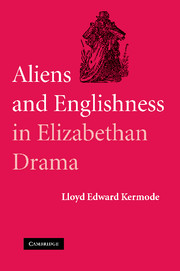Book contents
- Frontmatter
- Contents
- Preface
- Acknowledgements
- 1 Introduction – aliens and the English in London
- 2 Discovering the alien in Elizabethan moral drama
- 3 Accommodating the alien in mid-Elizabethan London plays
- 4 Incorporating the alien in Shakespeare's second tetralogy
- 5 Being the alien in late-Elizabethan London plays
- Postscript: Early modern and post-modern alien excursions
- Notes
- Bibliography
- Index
Preface
Published online by Cambridge University Press: 28 June 2009
- Frontmatter
- Contents
- Preface
- Acknowledgements
- 1 Introduction – aliens and the English in London
- 2 Discovering the alien in Elizabethan moral drama
- 3 Accommodating the alien in mid-Elizabethan London plays
- 4 Incorporating the alien in Shakespeare's second tetralogy
- 5 Being the alien in late-Elizabethan London plays
- Postscript: Early modern and post-modern alien excursions
- Notes
- Bibliography
- Index
Summary
NOTE ON THE FRONTISPIECE
The frontispiece and cover illustration is from Jost Amman's Gynaeceum, sive, Theatrum mulierum [The Theatre of Women] (1586). The book is a collection of prints from fine wood engravings, each image accompanied by eight lines of Latin text by François Modius (1556–97). The title-page notes that the book is designed to present ‘The female costumes of all the principal nations, tribes, and peoples of Europe … in commendation of the female sex, and for the especial gratification of such as by their manner of ordinary life, or from other causes, are hindered from distant travel, but at the same time take pleasure at home in the costume of various people, which is a silent index of their character.’ Costumed appearance of figures is of primary importance throughout this study as various dramatic ‘types’ and disguises question early modern notions of social, political, gendered, and religious ‘character’. Amman's ‘married lady of London’ is what Pisaro's daughters are aspiring to in their attempt to shed their Portuguese nationality in William Haughton's Englishmen for My Money. This matron also, according to the dedicatory letter by the printer Sigmund Feyerabend of Frankfurt (1528–90), represents a moral goodness that we see being strived for in Robert Wilson's The Three Ladies of London. The text accompanying the image tells us that Amman's London matron has rosy cheeks deserving of a wealthy husband.
- Type
- Chapter
- Information
- Aliens and Englishness in Elizabethan Drama , pp. ix - xPublisher: Cambridge University PressPrint publication year: 2009

